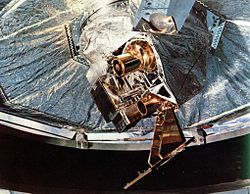Mariner 4
Mariner 4 was a NASA spacecraft. It was the fourth spacecraft in the Mariner program. It was sent on a Mars flyby mission. It was the first successful mission to Mars. The spacecraft was launched on November 28, 1964 at Cape Canaveral Air Force Station. Mariner 4 reached Mars after an eight-month journey. The spacecraft became the first spacecraft to take close-up photographs of another planet. The spacecraft also had other instruments to study the atmosphere of Mars.
 The Mariner 4 spacecraft | |
| Mission type | Mars flyby |
|---|---|
| Operator | NASA / JPL |
| COSPAR ID | 1964-077A |
| SATCAT no. | 942 |
| Mission duration | 3 years, 23 days |
| Spacecraft properties | |
| Manufacturer | Jet Propulsion Laboratory |
| Launch mass | 260.8 kilograms (575 lb) |
| Power | 310 watts (at Mars encounter) |
| Start of mission | |
| Launch date | November 28, 1964, 14:22:01 UTC |
| Rocket | Atlas LV-3 Agena-D |
| Launch site | Cape Canaveral LC-12 |
| End of mission | |
| Last contact | December 21, 1967 |
| Orbital parameters | |
| Reference system | Heliocentric |
| Semi-major axis | 199,591,220 kilometers (124,020,230 mi) |
| Eccentricity | 0.17024754 |
| Perihelion | 165,611,300 kilometers (102,906,100 mi) |
| Aphelion | 233,571,130 kilometers (145,134,370 mi) |
| Inclination | 2.51 degrees |
| Period | 562.888 days |
| Flyby of Mars | |
| Closest approach | July 15, 1965, 01:00:57 UTC |
| Distance | 9,846 kilometers (6,118 miles) |
| Instruments | |
| Cosmic dust detector Cosmic ray telescope Geiger counter/ionization chamber Helium magnetometer Solar plasma probe Trapped radiation detector TV camera | |
The total cost of the Mariner 4 mission is estimated at $83.2 million. Total research, development, launch, and support costs for the Mariner series of spacecraft (Mariners 1 through 10) was approximately $554 million.
Mariner 4 Media
Jack N. James (center), JPL's Mariner 4 Project Manager, with a group in the White House presenting the spacecraft's famous picture Number 11 of Mars to US President Lyndon B. Johnson (center right) in July 1965








